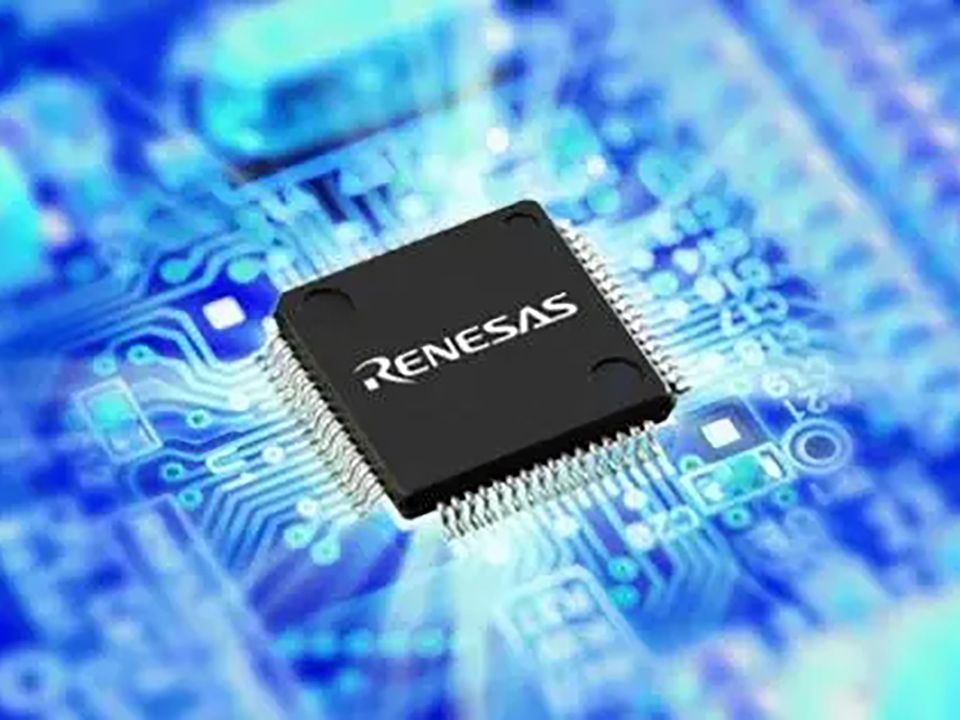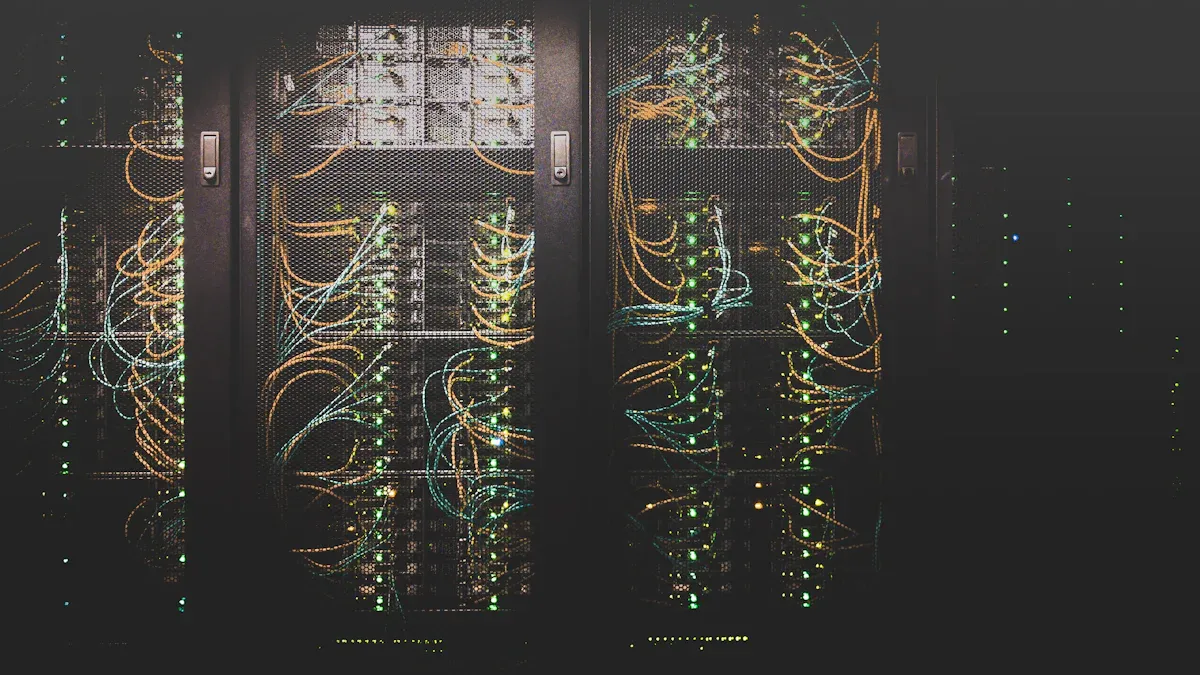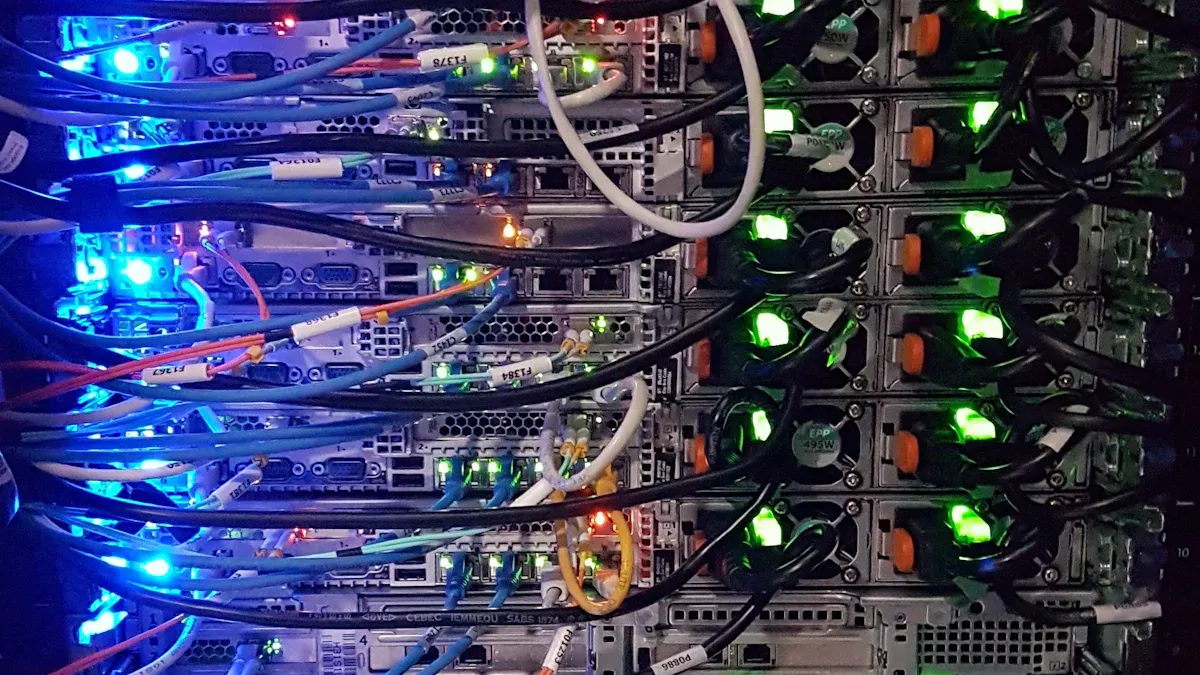How Renesas Tackles Power Efficiency in AI Data Centers

Renesas and the Age of GaN transform the landscape of AI data centers through advanced power solutions. Their cutting-edge technologies, including GaN (Gallium Nitride), redefine power efficiency and performance in AI workloads. GaN technology enables faster switching speeds and higher efficiency, making it ideal for high-frequency applications. As a leading Renesas distributor, the company’s acquisition of Transphorm strengthens its expertise in high-voltage GaN systems, offering tailored solutions for demanding environments. These innovations allow AI data centers to optimize energy management, enhance performance, and ensure sustainability. By integrating GaN devices with power management ICs, Renesas delivers unmatched solutions that meet the growing demands of modern data centers.
Key Takeaways
GaN technology helps AI data centers save energy. It works by switching faster and losing less energy during power changes.
Cooling systems like liquid immersion cooling keep things cool. They help machines work well even when very busy.
Special materials like GaN and SiC are very efficient. They handle heat better, making them great for powerful AI tasks.
Power Management ICs (PMICs) save energy by controlling voltage and current. This reduces waste and makes systems work better.
Renesas cares about the planet. They use green tech to cut energy use and lower carbon footprints in AI data centers.
The Growing Power Challenges in AI Data Centers

The Impact of AI on Data Center Power Demands
Artificial intelligence has revolutionized industries, but its rapid adoption has created significant power challenges for data centers. AI-driven applications, such as machine learning and natural language processing, require immense computational resources. This demand has led to a sharp increase in power consumption. In 2022, data centers consumed approximately 460 terawatt-hours (TWh) of electricity, accounting for about 2% of global electricity usage. Projections indicate this figure could double by 2026, driven by AI workloads. Goldman Sachs estimates a 160% rise in data center power demand by 2030, with AI contributing significantly to this growth.
Processing AI workloads also consumes more power compared to traditional tasks. For instance, a single query on ChatGPT requires about 2.9 watt-hours, nearly ten times the energy needed for a Google search. The training phase of advanced AI models, such as GPT-3, consumed approximately 1,300 megawatt-hours of electricity. These figures highlight the growing strain on power systems as AI adoption accelerates.
Challenges in Energy Efficiency and Heat Management
The increasing power demands of AI data centers bring unique challenges in energy efficiency and heat management. AI workloads often cause power fluctuations of hundreds of megawatts within seconds, creating instability in power grids. Cooling systems, which account for 30–40% of total energy consumption in data centers, struggle to manage the heat generated by high-performance computing systems. Traditional air-cooling methods are becoming inadequate as AI racks exceed 40 kW. Advanced cooling technologies, such as immersion cooling, have emerged as effective solutions, offering nearly 50% energy savings compared to conventional methods.
However, these innovations require significant investment and infrastructure upgrades. Delays in power supply, backlogged equipment orders, and grid constraints further complicate the situation. A recent survey revealed that 92% of industry leaders identified grid limitations as the top obstacle for data center projects, with 44% reporting utility wait times exceeding four years.
The Need for Advanced Power Solutions
The challenges posed by AI workloads necessitate advanced power solutions to ensure sustainability and operational efficiency. AI data centers are projected to account for a 165% increase in power demand by 2030. This growth underscores the need for technologies that enhance energy conversion efficiency and stabilize power systems. Diesel generators and lithium-ion batteries, commonly used for backup power, are unsuitable for AI operations due to their slow response times and environmental risks.
Innovative solutions, such as wide-bandgap semiconductors and digital power management systems, offer promising alternatives. These technologies improve energy efficiency, reduce heat generation, and support high-performance computing. By adopting advanced power solutions, data centers can address the growing power challenges and meet the demands of artificial intelligence.
Renesas and the Age of GaN

Advantages of GaN Over Traditional Silicon
Gallium Nitride (GaN) technology has emerged as a transformative solution in power systems, surpassing traditional silicon in several critical aspects. Research highlights that GaN semiconductor devices deliver increased efficiency, faster switching speeds, and superior power handling capabilities. These features enable significant energy savings and the creation of smaller, lighter power modules. Industries such as electric vehicles and renewable energy systems benefit greatly from these advancements, showcasing GaN's versatility across diverse applications.
Renesas and the age of GaN redefine power management by leveraging these advantages to address the growing demands of AI data centers. Unlike silicon, GaN operates effectively at higher voltages and frequencies, making it ideal for high-performance systems. Its ability to minimize energy losses during power conversion ensures optimal efficiency, reducing operational costs and environmental impact. By integrating GaN into their solutions, Renesas empowers data centers to achieve unparalleled performance and sustainability.
Tip: GaN's ability to handle higher voltages and frequencies makes it a game-changer for modern power systems, especially in AI-driven environments.
GaN's Role in Enhancing Power Density and Efficiency
GaN technology plays a pivotal role in enhancing power density and efficiency, addressing the critical needs of AI data centers. Comparative studies reveal several measurable improvements:
GaN enables higher switching frequencies without compromising efficiency or thermal limits.
Systems utilizing GaN experience lower motor temperatures, boosting overall performance.
Reduced bulk capacitance requirements allow for smaller system sizes, optimizing space utilization.
Renesas and the age of GaN capitalize on these benefits to deliver cutting-edge solutions for AI workloads. By improving power density, GaN technology supports compact designs that maximize infrastructure efficiency. This is particularly valuable for data centers, where space constraints and energy demands continue to rise. Renesas integrates GaN into its systems to ensure reliable, high-performance operations while minimizing energy consumption.
Thermal Performance and Space Optimization with GaN
GaN technology excels in thermal performance and space optimization, making it indispensable for AI data centers. Performance metrics demonstrate its superiority in reducing thermal resistance (RθJA) and managing heat effectively. The following table illustrates key improvements achieved through optimized GaN designs:
Evidence Description | Impact on RθJA | Temperature Reduction |
|---|---|---|
Doubling copper thickness from 1 oz to 2 oz | Reduced RθJA by 21% | N/A |
Adjacent vias layout compared to no via | 22% decrease in RθJA | N/A |
Under-bump design layout | 33% decrease in RθJA | N/A |
Combining techniques | Reduced RθJA by close to 30% | N/A |
Optimized design | Over 35% reduction in RθJA and >20°C temperature drop | >20°C |
Renesas and the age of GaN leverage these advancements to enhance thermal management in AI systems. By reducing heat generation and improving cooling efficiency, GaN technology ensures reliable operations even under intense workloads. Its compact design further optimizes space utilization, enabling data centers to accommodate more systems without compromising performance. Renesas continues to innovate in this area, delivering solutions that combine thermal efficiency with space-saving designs to meet the evolving needs of AI-driven environments.
Renesas' Key Technologies for Power Efficiency
Wide-Bandgap Semiconductors (SiC and GaN)
Renesas employs wide-bandgap semiconductors like Silicon Carbide (SiC) and Gallium Nitride (GaN) to revolutionize power systems in AI data centers. These materials outperform traditional silicon by enabling higher efficiency, faster switching speeds, and superior thermal endurance. SiC excels in high-voltage applications, reducing conduction losses and ensuring reliable performance under extreme conditions. GaN, on the other hand, offers enhanced efficiency and compact designs, making it ideal for space-constrained environments.
The table below highlights the advantages and applications of these semiconductors:
Semiconductor | Advantages | Applications |
|---|---|---|
GaN | Enhanced efficiency, compact form factor, rapid switching | DC/DC converters, DC/AC inverters |
SiC | High voltage operation, reduced conduction losses, thermal endurance | DC/DC converters, DC/AC inverters |
Renesas integrates these technologies into its power solutions to address the growing demands of AI data centers. By leveraging SiC and GaN, Renesas ensures optimal energy conversion, reduced heat generation, and improved system reliability.
Digital Power Management for AI Workloads
Digital power management technologies play a critical role in optimizing energy usage for AI workloads. Renesas incorporates advanced power management ICs to enhance efficiency and performance in AI data centers. These ICs enable precise control over power delivery, ensuring stable operations even during fluctuating workloads.
Efficiency improvements achieved through digital power management are significant. For example, GPUs save over 40 terawatt-hours of energy annually compared to CPUs, meeting the electricity needs of nearly 5 million U.S. homes. The NVIDIA Grace Hopper Superchip reduces energy consumption by four times and accelerates task completion by seven times, as demonstrated in financial services testing. RAPIDS Accelerator for Apache Spark achieves an 80% reduction in carbon footprint while delivering five times faster processing speeds.
The table below summarizes these advancements:
Technology/Method | Efficiency Improvement | Additional Notes |
|---|---|---|
GPU vs. CPU | 40+ terawatt-hours energy savings annually | Equivalent to electricity needs of nearly 5 million U.S. homes |
NVIDIA Grace Hopper Superchip | 4x reduction in energy consumption, 7x reduction in time to completion | Tested by Murex in financial services |
RAPIDS Accelerator for Apache Spark | 80% reduction in carbon footprint, 5x speedup, 4x reduction in computing costs | Widely used for data analytics |
Micron HBM3E | 30% lower power consumption | Compared to competitive offerings |
DDR5 | Up to 48% lower power consumption in AI inference | Efficient for inference tasks |
Micron 7450 SSD | 50% increase in power efficiency | Twice the throughput of 7300 SSD with same power consumption |
Renesas' digital power management solutions empower AI data centers to achieve unparalleled efficiency and sustainability.
Thermal Management Innovations
Thermal management remains a cornerstone of Renesas' approach to power efficiency in AI data centers. Advanced cooling technologies ensure reliable operations and prevent overheating during intense workloads. Liquid immersion cooling has emerged as a game-changing innovation. Intel's lab in Oregon uses synthetic non-electrically conductive oil to cool servers, demonstrating the effectiveness of this method.
The Liquid Cooling Coalition (LCC), supported by industry leaders like Intel, Shell, and Supermicro, promotes the adoption of liquid cooling solutions. These systems reduce energy consumption and enhance sustainability, aligning with the growing need for eco-friendly data centers.
Key innovations in thermal management include:
Liquid immersion cooling technologies tested in AI environments.
Synthetic oil-based cooling systems utilized by Intel's lab.
Industry-wide support for liquid cooling through the LCC.
Renesas integrates these innovations into its power management ICs to deliver efficient cooling solutions. By reducing heat generation and optimizing cooling systems, Renesas ensures consistent performance and longevity for AI data centers.
Integrated Solutions for AI Data Centers

PMICs (Power Management ICs) for System-Level Efficiency
Power Management ICs (PMICs) play a vital role in improving system-level efficiency in AI data centers. These integrated circuits manage power delivery across systems, ensuring stable and efficient operations. PMICs optimize energy usage by regulating voltage and current, reducing energy waste, and enhancing overall performance. Their ability to maintain voltage regulation accuracy and temperature stability makes them indispensable for AI workloads.
The following table highlights key metrics that validate the effectiveness of PMICs in improving system-level efficiency:
Metric | Description |
|---|---|
Power Consumption | Reflects energy consumption, divided into static and dynamic power consumption. |
Conversion Efficiency | Indicates how effectively input power is converted to output power. |
Voltage Regulation Accuracy | Measures the stability of the output voltage from the PMIC. |
Current Control Accuracy | Assesses the stability of the output current from the PMIC. |
Temperature Control Accuracy | Evaluates the stability of the chip's temperature during operation. |
Response Speed | Describes how quickly the PMIC responds to input signals. |
Reliability | Indicates the performance and lifespan of the PMIC under prolonged use and frequent switching. |
Renesas integrates PMICs into its solutions to ensure reliable power delivery and efficient energy management, meeting the growing demands of AI data centers.
Voltage Regulators and Drivers for Optimized Power Delivery
Voltage regulators and drivers are essential for optimized power delivery in AI systems. Recent innovations in wide-bandgap semiconductor materials, such as silicon carbide (SiC) and gallium nitride (GaN), have significantly enhanced the efficiency and performance of switching regulators. These advancements enable faster and more efficient power conversion, reducing energy losses and improving system reliability.
Key developments in voltage regulators include:
Integrated circuits that combine voltage regulation with other functions, leading to smaller and more efficient designs.
Applications in smart homes and grids, where they manage power in systems like smart meters and energy storage.
Critical roles in 5G technology and edge computing, delivering power to distributed systems efficiently.
Renesas leverages these technologies to provide cutting-edge solutions that ensure stable and efficient power delivery, even under the intense workloads of AI data centers.
Comprehensive Integration for Enhanced Performance
Comprehensive integration of power systems enhances performance and efficiency in AI data centers. Electrical integration connects and coordinates different systems, creating a unified and efficient setup. This approach reduces energy waste, improves safety, and optimizes resource use. Centralized control allows for comprehensive monitoring, reducing energy consumption and enabling faster incident response times.
Key benefits of system integration include:
Smoother operations with less manual intervention.
Reduced operational costs through better coordination.
Enhanced safety and reliability in power delivery systems.
Renesas' integrated solutions combine advanced PMICs, voltage regulators, and drivers to deliver unmatched performance and efficiency. These innovations empower AI data centers to meet the growing demands of artificial intelligence while maintaining sustainability and operational excellence.
Future Trends and Sustainability in Power Management
AI-Optimized Power Solutions for Next-Gen Data Centers
AI-optimized power solutions are transforming the way data centers operate, enabling smarter and more efficient systems. Predictive maintenance tools powered by AI identify early signs of equipment failure, reducing downtime and repair costs. Demand forecasting technologies adjust power generation based on real-time data, minimizing waste and improving stability. Drone inspections, equipped with AI capabilities, enhance safety and efficiency by quickly assessing infrastructure conditions.
Trend | Description |
|---|---|
Predictive Maintenance | Tools that identify early signs of equipment failure, reducing downtime and repair costs. |
Demand Forecasting | Enables adjustments in power generation based on real-time data, minimizing waste and improving stability. |
Drone Inspections | AI-powered drones inspect infrastructure quickly, enhancing safety and efficiency in maintenance. |
These advancements highlight the growing role of AI in optimizing power management for next-generation data centers. By leveraging these solutions, operators can achieve higher performance, lower costs, and improved sustainability.
Renesas' Commitment to Green Technologies
Renesas demonstrates a strong commitment to green technologies by integrating eco-friendly practices into its power solutions. The company focuses on reducing energy consumption and carbon footprints through innovative designs. Predictive analytics optimize energy usage and resource allocation, reducing waste and saving costs for data centers. Renesas also supports the adoption of liquid cooling systems, which significantly lower energy consumption compared to traditional methods.
The average power usage effectiveness (PUE) rating for data centers has improved from 2.5 in 2007 to 1.56 in 2024. Renesas aims to help centers achieve a PUE rating of 1.2 or less by implementing advanced power management systems. These efforts align with the global push for sustainability, ensuring that AI data centers remain efficient while minimizing their environmental impact.
Note: Renesas' green technologies empower data centers to balance high performance with environmental responsibility.
The Future of Power Efficiency in AI Data Centers
The future of power efficiency in AI data centers relies on advanced forecasting models and innovative technologies. Decision trees and regression models analyze relationships between variables, enabling better energy management. Time series analysis predicts future outcomes based on historical data, helping centers optimize operations. Forecast models produce numerical values that guide energy-saving strategies.
Decision Trees: Categorize variables based on relationships for visual understanding.
Regression Models: Analyze dependent and independent variables, such as energy consumption.
Time Series Analysis: Predict outcomes using historical data trends.
Forecast Models: Generate numerical predictions for energy efficiency improvements.
Data centers focusing on energy efficiency can achieve remarkable results, including a PUE rating of 1.2 or less. These advancements reduce energy waste, lower operational costs, and enhance system reliability. Renesas continues to lead the charge in developing solutions that address the growing demands of AI while prioritizing sustainability.
Renesas addresses the growing power challenges in AI data centers with innovative solutions that enhance efficiency and performance. Their technologies, including GaN and digital power management systems, optimize energy usage while supporting high-performance AI workloads. By integrating advanced systems, Renesas ensures reliable operations and sustainable practices for modern data centers. Their commitment to innovation positions them as a leader in power management, enabling AI data centers to meet future demands with confidence.
What makes GaN technology ideal for AI data centers?
GaN technology enables faster switching speeds and higher efficiency. It minimizes energy losses during power conversion and supports compact designs. These features make it perfect for handling the intense workloads and space constraints of AI-driven environments.
How does Renesas improve thermal management in AI systems?
Renesas integrates advanced cooling technologies like liquid immersion cooling. These systems reduce heat generation and enhance cooling efficiency, ensuring reliable operations even under heavy workloads.
Why are wide-bandgap semiconductors important for AI workloads?
Wide-bandgap semiconductors, such as GaN and SiC, offer superior efficiency and thermal endurance. They support high-performance computing by reducing energy consumption and improving system reliability.
How do PMICs enhance power efficiency in AI data centers?
PMICs regulate voltage and current across systems, reducing energy waste and ensuring stable operations. Their precise control over power delivery optimizes energy usage and enhances performance.
What role does Renesas play in sustainability for AI data centers?
Renesas focuses on green technologies, such as liquid cooling and predictive analytics, to reduce energy consumption and carbon footprints. These innovations help data centers achieve sustainability without compromising performance.
See Also
Unleashing AI Edge Computing Through RV1126 in Robotics
Explore LPQ252-CEF: A Solution for Power Efficiency
Empowering Industrial Automation with ARTESYN NPT42-M Technology
Integrating AEAT-8800-Q24 to Boost Robotics Performance Effectively
CALL US DIRECTLY
(+86)755-82724686
RM2508,BlockA,JiaheHuaqiangBuilding,ShenNanMiddleRd,Futian District,Shenzhen,518031,CN
www.keepboomingtech.com sales@keepboomingtech.com
